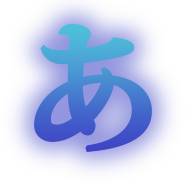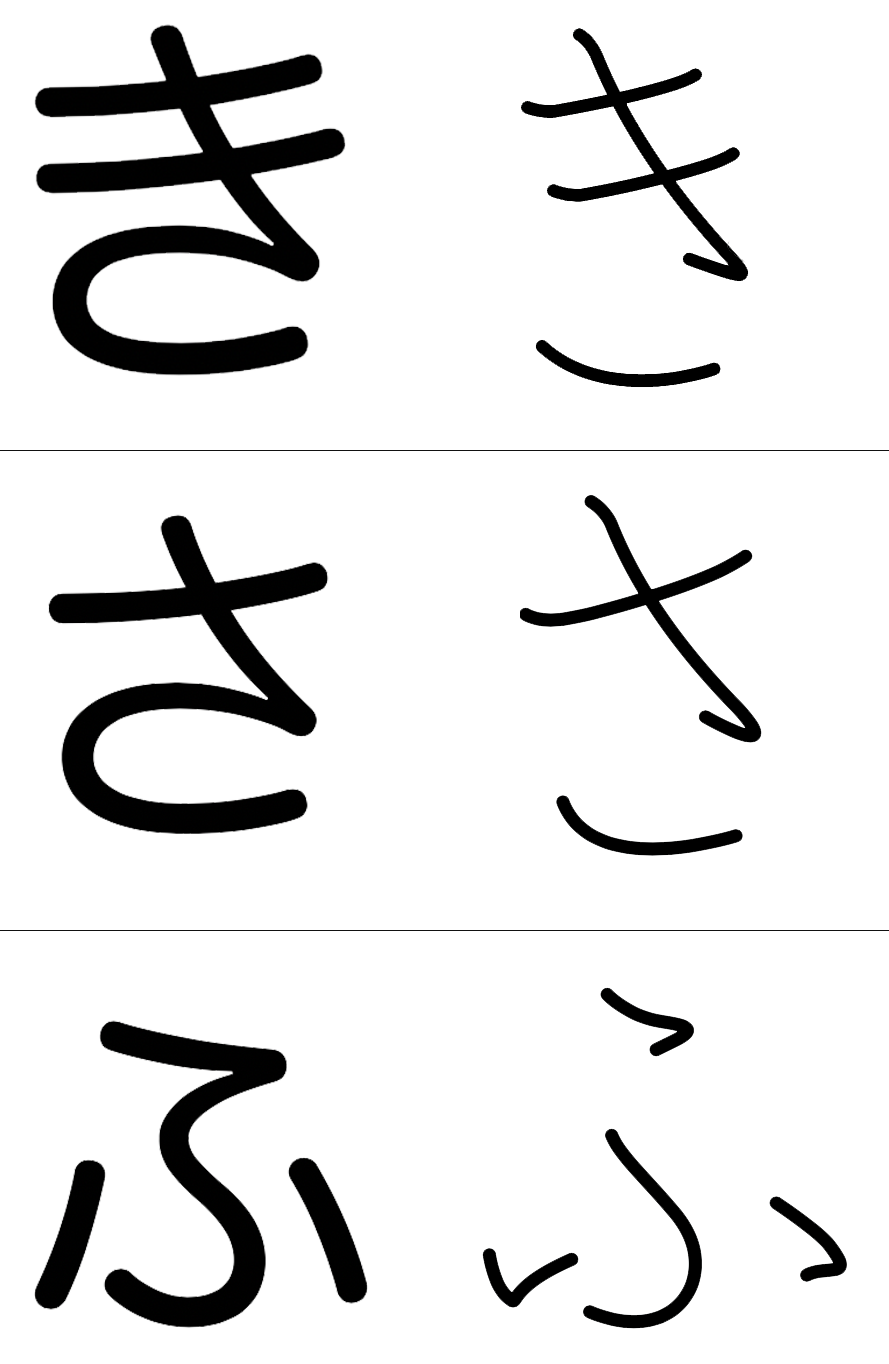Hiragana

Hiragana is one of the two Japanese 'syllabaries', the writing systems used to
represent the sounds of Japanese syllables. If you are just starting out with your Japanese studies, learning
hiragana is one of the most useful first steps you can take.
Hiragana symbols are used in all Japanese sentences to represent grammatical constructions such as verb endings and particles, as well as for words for which there are no kanji or only less common kanji.
If you are just starting out with your Japanese studies, learning hiragana is the most useful first step. Once you have learnt hiragana, your second step should be the other syllabary, katakana.
For more information on how to go about learning written Japanese, see our
other detailed guides:
Contents
The basic hiragana chart is as follows.
| あ | か | さ | た | な | は | ま | や | ら | わ | ん |
| a | ka | sa | ta | na | ha | ma | ya | ra | wa | n |
| い | き | し | ち | に | ひ | み | り | |||
| i | ki | shi | chi | ni | hi | mi | ri | |||
| う | く | す | つ | ぬ | ふ | む | ゆ | る | ||
| u | ku | su | tsu | nu | fu | mu | yu | ru | ||
| え | け | せ | て | ね | へ | め | れ | ゛ | ||
| e | ke | se | te | ne | he | me | re | dakuten | ||
| お | こ | そ | と | の | ほ | も | よ | ろ | を | ゜ |
| o | ko | so | to | no | ho | mo | yo | ro | (w)o | handakuten |
The 'dakuten' symbol ( ゛) and the 'handakuten' symbol ( ゜) are not used on their own -
they are used to modify the hiragana symbols they appear after.
When ゛is displayed after
another hiragana symbol, it indicates that the symbol should be 'voiced'. 'Voicing' is a linguistic term
for a sound that makes the vocal cords vibrate - as opposed to just emanating from the mouth. In
Japanese, this means that the sound of a consonant moves further down your throat. So, for example, the
unvoiced sound か (ka) becomes the voiced sound が (ga).
When ゜is displayed after a hiragana symbol, it changes the sound to a 'p' sound, so for
example,
は (ha) becomes ぱ (pa).
| が | ざ | だ | ば | ぱ |
| ga | za | da | ba | pa |
| ぎ | じ | び | ぴ | |
| gi | ji | bi | pi | |
| ぐ | ず | ぶ | ぷ | |
| gu | zu | bu | pu | |
| げ | ぜ | で | べ | ぺ |
| ge | ze | de | be | pe |
| ご | ぞ | ど | ぼ | ぽ |
| go | zo | do | bo | po |
The basic hiragana can be modified in a couple more ways. Hiragana ending in 'i' can
be followed by a small ya, yu or yo (ゃ, ゅ or ょ), which elides the sounds of the two characters. For example,
き (ki) plus や (ya) would become きゃ (kya). This type of modification is known as 'yōon'.
| きゃ | ぎゃ | しゃ | じゃ | ちゃ | にゃ |
| kya | gya | sha | ja | cha | nya |
| きゅ | ぎゅ | しゅ | じゅ | ちゅ | にゅ |
| kyu | gyu | shu | ju | chu | nyu |
| きょ | ぎょ | しょ | じょ | ちょ | にょ |
| kyo | gyo | sho | jo | cho | nyo |
| ひゃ | びゃ | ぴゃ | みゃ | りゃ |
| hya | bya | pya | mya | rya |
| ひゅ | びゅ | ぴゅ | みゅ | りゅ |
| hyu | byu | pyu | myu | ryu |
| ひょ | びょ | ぴょ | みょ | りょ |
| hyo | byo | pyo | myo | ryo |
Finally, a small っ can be used between two hiragana to double the second consonant.
For example, いって is read as 'itte'. This is known as a 'sokuon'.
When hiragana symbols are used to inflect kanji-based words, they are known as
'okurigana'. For example, in the word 高い (たかい, high / expensive), the い is an okurigana.
Hiragana symbols are
also written above (or beside) kanji to indicate their pronunciation, especially
names, in which case they are known as 'furigana'. For example, the surname
たなか, Tanaka, could be written like this, using furigana:
た
田
なか
中
To learn the hiragana, there is no substitute for lots of practice! Practice your recognition with
flashcards (use the link at the top of this guide), develop muscle memory by practicing drawing, and take
the Kanshudo Challenge to learn and test hiragana in context.
Most importantly of all, practice using hiragana by reading Japanese sentences whenever you can.
Use our Hiragana Drawing Practice, or practice any individual
hiragana by using one of the links below.
Several hiragana can appear quite different when displayed in different fonts - even to the point
of having different stroke counts when compared with the common handwritten versions. Additionally, the printed versions of
some characters are a little different to the standard way of drawing the characters (which is the form Kanshudo's
drawing practice uses). These differences are especially common for the following characters: き, さ, そ, ふ, ゆ and り.
For example, when き is drawn by hand, it is typically composed of four strokes,
and the fourth stroke forms a curve at the underside of the character which is entirely separate from the lattice made by the
first three characters. However, in most printed fonts, the third stroke joins the fourth stroke, leading to a character which
appears to be made of only three strokes.
None of these differences is 'incorrect', and you will need to recognize the various versions as you will
encounter them in the real world. A similar issue exists with certain kanji.
The following image shows typical printed forms on the left and the standard handwritten forms on the right:

Note: there is no need to read this section when you are first learning hiragana! This section will become more useful as you start to encounter kana in a wider variety of situations.
Hiragana evolved over time, and in some cases multiple variants of characters came into use. Additionally some characters represent sounds that are no longer common in contemporary Japanese. You may still encounter these characters in names of products or stores, for example, as a way of expressing 'authenticity'.
ゑ represented the 'we' sound, which was pronounced 'i-e' in classical Japanese, distinct from the modern え sound. This character is still encountered in the name of the popular beer, ゑびす - but it is pronounced as Ebisu in both English and Japanese.
In the same way ゐ represented 'wi', which is no longer distinguished from い.
Two more symbols are officially part of hiragana: ゝ and ゞ. These are each used to indicate that the previous hiragana symbol is repeated - the dakuten form ゞ indicates that it is voiced. For example, こゝろ would be read こころ, and いすゞ would be read いすず. For more details on repetition symbols, see 々, 〻, 〱, ゝ and ヽ kanji and kana repetition symbols.
Kanshudo is your AI Japanese tutor, and your constant companion on the road to mastery of the Japanese language.
To get started learning Japanese, just follow the study recommendations on your Dashboard.
You can use Quick search (accessible using the icon at the top of every page) to look up any Japanese word, kanji or grammar point, as well as to find anything on Kanshudo quickly.
For an overview, take the tour.
